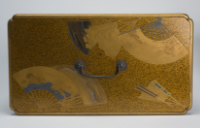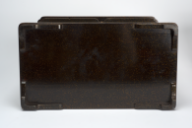Autumn is Coming
The outer structure of the sagejūbako works as a frame and container for the other components of the set, and in a way, it seems to “set the tone” for the autumnal decorative motif, which follows the same themes on its other components.
The whole body of the frame shows a decoration of sprinkled golden powder on a dark background: this decorative technique is called nashiji maki-e (梨子地 蒔絵). Maki-e is the name given to the techniques which involve the sprinkling of golden or silver dust onto lacquer, and the term nashiji is tied to the resulting effect, which is reminiscent of the skin of a Japanese pear, nashi. The density of the gold flakes changes throughout the outer structure: the flakes are sprinkled much more densely top and sides, whereas the dark background is much more apparent at the bottom.
The technique of maki-e was also used to create the designs present on the frame. These designs are in the shape of fans, and were achieved by tracing the design onto the surface, and then by applying red lacquer to it. While the lacquer was still wet, gold dust was sprinkled onto it until the desired coverage was reached.
Fans are a decorative motif often found on Japanese lacquerware, and fans themselves were also an object typical of Japanese crafts. The decorative fans on our set are not dissimilar from the painted fans which were produced in the same time frame: for example, a fan from the collection of the British Museum shares many characteristics with one of the golden fans found at the top of the frame. Both show a remote building in a rocky landscape surrounded by trees and close to the shoreline.
Close to this fan with a landscape we find another one with a scenic view: this time we see the top of a group of trees set against a dark sky, in which a line of birds is flying. The birds could be geese, which migrate to Japan in the autumn season and stay for the winter. This seems to be in line with the decoration on the fan next to it, a delicate looking susuki grass, a plant also tied to the autumn season.
Several other decorative fans can be seen on the outer frame, and are mostly decorated with chrysanthemum flowers: these autumnal flowers are also found on the bottle of this set, which will be the focus of our next marker.




](https://micrio.thingsthattalk.net/KsSdq/views/max/263x128.jpg)
](https://micrio.thingsthattalk.net/GpecM/views/max/173x128.jpg)